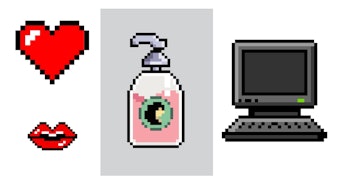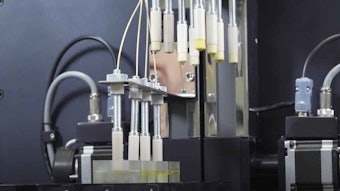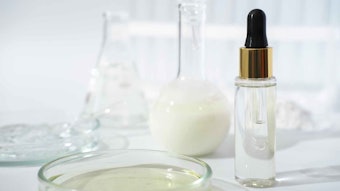by Pierfrancesco Morganti, PhD, Mavi Sud srl, Aprilia (LT), Italy
Biofunctional textiles, innovative cosmeceuticals and nutraceuticals were among the more than 200 topics presented at the 8th International Congress of International Society of Cosmetic Dermatology on October 20-23, 2007 in Beijing. Health beauty, joy and high science were the symbols of this interesting meeting. The scientific papers were well selected from the scientific board chaired by Prof. Wei Liu Head of the dermatology department at General Hospital Air Force and Xuejun Zhang, president of the Chinese Medical Association.
Skin’s Function
The natural function of the skin is to protect of the body against the loss of endogenous substances such as water and against environmental influences caused by exogenous substances. Its basic function includes protection against physical, chemical, and microbiological stimuli; secretion of sweat and sebum; regulation of body temperature; sensation of various outside changes; and serving as part of immune system (Fig.1). While it has been known for a long time that various physico-chemical features, including low pH, contribute to the naturally protective milieu of the skin, it is a rather recent discovery that skin and other epithelia harbor a large array of naturally occurring antimicrobial peptides, forming an important part of the innate immune system. Thus, epithelial defense against infection agents relies on the recognition of microbial products by pattern recognition receptors and the local production of antimicrobial peptides.
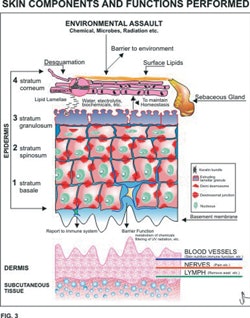
Caption: Without Dida
These toll-like receptors are early sensors of microbial material in both epithelial cells and dendritic cells, thus initiating immune responses before the specific or immune system is alerted. However, human skin spends most of its time in close contact with clothing and garments made up of different fibers. Therefore, the basic function of clothing should be in line with the basic function of human skin. Innovative clothing should provide more protection than the natural skin. To that end, completely new textile technologies have recently been developed worldwide with the goal of giving additional functionality to garments.
Functional Textiles
Nowadays, textiles have been improved for different needs such as UV and/or toxic gases protection, enhancing breath ability or to protect against microorganisms such as bacteria and fungi. In addition, they may have integrated sensors to diagnose medical conditions (Fig.2) or may be equipped with carrier molecules to absorb substances from the skin and release therapeutic compounds (Fig.3).
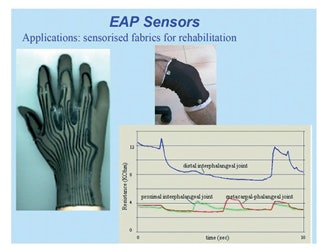
Caption: Sensor on Textiles to Diagnose Medical Conditions
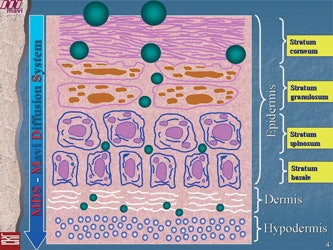
Caption: The Cosmetic Carrier Composed of Particles of Different Size May Have a Major or Minor Penetrability Power.
This was the focus of Prof. Hong –Duo Chen, Prof. Xing-Hua Gao and Yu-Xiao Hung from the well- known China Medical University in Shenyang. China has the biggest production volume of textiles, and people there are becoming more and more aware of the unwanted effects clothing may have on human health. Therefore, according to the scientists, Chinese dermatologists are paying much more attention to the safety of clothing, and fibers of different functions are being developed. Meanwhile, the textile industry is booming and dermatologists have established a bridging role in testing and evaluating all the effects of fibers on the skin in both lab and clinic settings. Innovative textiles may be produced by the use of the Italian-patented chitin nanofibrils with new properties and significant advantages, for example in wound care. This natural and safe polyglucoside may be constructed with other fibers of different densities to enhance and optimize the direct transport of fluids into the textile (Fig.4).
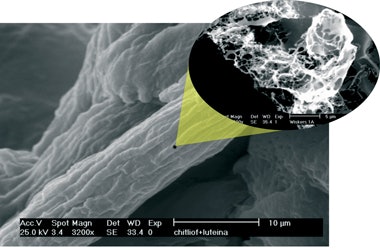
Caption: Textile Produced from Chitin' Nanofibrils.
It may be used also to produce quality and natural textiles exhibiting antibacterial activities with an improved level of comfort. But according to the opening topic of this article, this nanostructured chitin may have an interesting use as a cosmetic and/or drug carrier, as a natural skin moisturizing ingredient or as biodegradable polymer for the engineering and regeneration of different tissues (Fig.5).
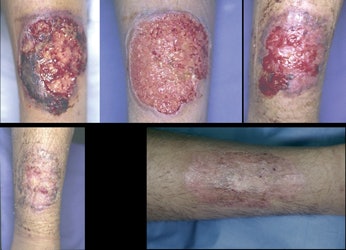
Caption: Activity of Chitin Nanofibrils on Wound Healing
Nanotechnology, therefore, will be able to spearhead innovation, giving new impetus to a globalized and even faster trade. But the ability to market nano-structured products will depend on the ability of companies to produce and control this new class of products, meeting the needs of both man and the environment; on the ability of government to regulate their production and use quickly and effectively; and on the ability of the products themselves to meet the needs and expectations of consumers. Biofunctional textiles, innovative cosmeceuticals and nutraceuticals were among the more than 200 topics presented on October 20-23, 2007 in Beijing.
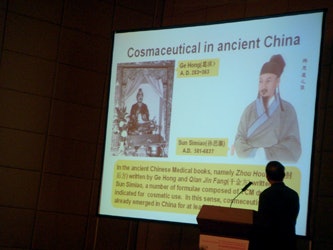
Caption: Professor Xiran Lin Describes the Activity of Traditional Chinese Medicine
Traditional Chinese Medicine in Personal Care
But what about Traditional Chinese Medicine (TMC)? According to Prof. Xiran Lin (Fig.6) of the Department of Dermatology at Dalian Medical University, cosmeceuticals have already been in China for at least 1700 years. In Zhou Hou Fang, a classical medical book of ancient China written by Ge Hong, formulas composed of traditional Chinese drugs, were used to improve people’s appearance. Since then, a number of traditional Chinese herbs such as Fructus trichosanthis, Radix angelicae sinesis and radix ginseng, etc. have been recorded in medical literatures in past dynasties to compose cosmetic formulas. These herbal medicines, according to the theoretical system of TCM, possess the actions of invigorating Qi, nourishing blood, removing blood stasis, eliminating heat, promoting the blood circulation, removing dampness and relieving itching. These actions will balance the Yin and Yang (Fig.7), coordinate the Qi and blood, promote the physiological function and consequently bring about a holistic cosmetic effect. This is why the traditional Chinese doctors refer to physiognomy, which is the study of discovering temperament and character from outward appearance. For this diagnosis, Chinese doctors often uses the Eight Character system to make a comprehensive analysis of the patient’s inborn and postnatal constitution as well as lifespan. The Eight Characters are in four pairs denoting the time, date, month and year of a person’s birth. The system is used in fortune telling and is based on I Ching, or The Book of Changes, a Taoist classic. In ancient times, TCM and Taoism were bound up in each other. Many Taoists were doctors, and nearly all doctors were Taoist.
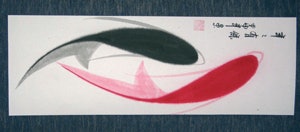
Caption: A Painting Representing Yin and Yang.
But on the heels of the conclusion of the Tang Dinasty (AD 618-907), TCM basically broke away from Taoism to become an independent branch. However, Taoism and TCM still shared similar philosophies and even the same literary classics.
Because a Taoist’s primary goal is to become immortal, Taoist culture is anchored in preserving health and extending longevity. The Taoist attitude towards life, diet and internal exercise means that practitioners enjoy long, healthy lives.
Under Taoist thought, people should replace all complicated emotions with serenity and temperance in order to stay healthy. Consequently the physical exercises performed are focused on breathing exercises and meditation. Moreover, it is important to balance a diet with foods of different colors and flavors (Fig.8).
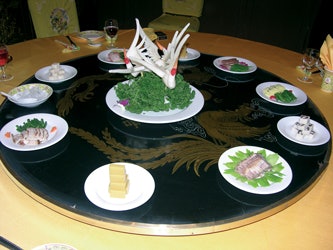
Caption: Colors and Flavors in Chinese Food.
Finally, it the relationship between the environment and good health is important. Thus, a bedroom decoration can lead, for example, to poor sleep if the Yin and Yang of the people living there is not balanced. The opposition between Yin and Yang, as well as the five elements (metal, wood, earth, water and fire) would lead to anxiety and affect sleep. Therefore, during the meeting, all the attendants had the opportunity to learn how a balanced Yin andYang may encourage harmony and balance with nature (Fig. 9).
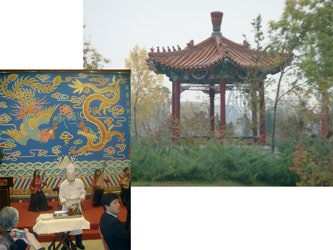
Caption: Harmony and Colors During the Meeting
A key difference between TCM and Western medicine is that TCM is more individually focused and treats everybody according to their unique circumstances. Thus the East well-being is anchored in preserving health and extending longevity because of people always behave in ways that are harmonious with nature rather than counter to nature. And this philosophy of living dominated the event’s participants for the entire three day congress.
Treating Pigment Disorder with Traditional Chinese Medicine
Pigment disorders are numerous and occur as a result of both genetic and environmental factors. Among these disorders, hypermelanosis is frequent and particularly troubling to darker-skinned individuals such as Asian women.
Freckles, solar lentigines, melasma and post-inflammatory hyperpigmentation are among the most commonly seen problems. The knowledge of melanocyte biology and processes underlying melanin synthesis has made remarkable progress over the last few years, opening new paths in the physiologic and/or pharmacologic approach to the treatment of hyperpigmentation. Now, depigmentation can be achieved by regulating: the transcription and activity of tyrosinase, tyrosinase related protein-1, protein-2, and/or peroxidase; the uptake and distribution of melanosomes in recipient keranocytes; the melanin and melanosome degradation; and the turnover of pigmented keratinocytes.
The transfer to and up-take of melanosomes within the keratinocytes suggests a feedback control mechanism regulating from the same keratinocytes. And this keratinocyte-melanocyte metabolic activity interrelationship should be based on the efficacy of new whitening cosmetic compounds. This seems to be the future trend of treating hypermelanosis worldwide, according with different topics presented and discussed by scientists such as Hailang Zhang Xijing of the Medical University, Jie Gao of the Nanjing Medical University, Leihong Xiang of the Fudan University of Shanghay, and Xuejun Zhang of Anhui Medical University.
Herbal Medicine, used systematically and topically, acupuncture, moxibustion massage and diet seem to be the main treatment modalities in cosmetic dermatology. Thus, more and more customers and dermatologists have turned to TMC for preventive and curative treatments in cosmetology. After thousands years of trial and error practice on humans, Chinese physicians have identified hundreds of herbs and food products that have cosmetic benefits. The combination of herbal formulas, fang ji, is a unique Chinese approach to cosmetic conditions. An herbal formula is always tailored to an individual customer/patient for a specific condition. Therefore, the last contributions highlighted from the ancient and modern Chinese therapies were focused from Yonk Ming Li of the American Traditional Chinese Medicine Society, Junyr Huang of the Beijing University of Chinese Medicine and Song Ping of the China Academy of Chinese Medical Sciences. The application of some herbal medicines in high-tech cosmetics products were discussed by Nuan Chen of the Shiseido China Research Center. He focused on the activity of some herbal medicine, demonstrating the advantages such as whitening, moisturizing and nourishing agents when used in the field of cosmeceuticals.
Natural Chemistry is an Oxymoron or a Pleonasm?
This was the interesting topic presented by Karl Lintner, general manager of Sederma/Croda. It was a non-commercial talk on today’s absurd opposition between chemistry and natural. Karl strongly asserted that this opposition represents a “cry against the rape of our language, the measure of words and terminology, a wake-up call to stop bashing chemistry”. This way of thinking is a danger for innovation and science in general. Cosmetics should be formulated to be safe and effective, whatever the source of material.
Protection from Photoaging
Mens sana in corpore sano, or a healthy mind in a healthy body, is a way of living. But intrinsic aging caused by genes and extrinsic aging cause by environmental factors such as UV rays and blue light, normally begins in the mid-20s. And striving for beautiful, healthy facial skin is a common aspiration for all people of the world with standards of attractiveness that are surprisingly universal. Thus, the new personalized medicine has become using lifestyle and the environment as principle tools in both presentation and treatment of skin photoaging.
In an attempt to block some of the damage incurred by sun exposure, antioxidants have been explored as a means to deal with UVR-induced oxidative stress, UVA and blue light radiation in particular. Oxidative stress has a complex etiology with multiple risk factors that involve the interplay between genetic and environmental influences. There is compelling evidence that suggests that sunscreens and dietary plant foods are protective against degenerative diseases. Some topical and systemic antioxidants include resveratrol, vitamin E, vitamin C, retynyl phosphate and lutein. As a potent antioxidant, vitamin C acts as a scavenger of free radicals and reactive oxygen generated during normal metabolism. This nutrient plays a major role in the manufacture of connective tissues and serves as the primary ingredient of collagen. Another beneficial effect is the control of excessive skin pigmentation by the suppression of melanin formation, thereby promoting skin whitening. All these observations came out during the topics presented by Tetsuo Shu of Daikanyam Clinic, Evangeline B. Handog of the Research Institute for Tropical Medicine and other scientists participating to the general discussion such as Hunchen Wei, a professor of dermatology at the Mt. Sinai School of Medicine.
Increasing awareness of the damaging effects of sunlight has led to a significant demand for improved photoprotection by the use of sunscreening agents. Thus, over the past few decades, there has been a continuous improvement in sunscreen formulation, especially in the development of broad-spectrum coverage sunscreens.
In addition to the conventional organic-chemical and the physical-mineral type sunscreens, a number of non-sunscreen sun protective strategies also have been investigated. Dietary carotenoids including lutein are delivered to play a role in maintaining skin and eye health by reducing UV and blue light damages, according to Kyochi Oshida of Kemin Health. The hydroxyl groups present on the rings of lutein-molecule are responsible for the more hydrophilic characteristics of this natural compound, allowing it to react with singlet oxygen more efficiently. In addition, lutein also filters high-energy, blue-light from the visible-light spectrum. Blue light, in both indoor lighting and sunlight is believed to induce oxidative stress and possible free-radical damage in human tissues exposed to light, such as the eyes and skin. Moreover, an Italian double-blind clinical study has recently elucidated that oral and/or topical lutein supplementation plays a role in skin aging, maintaining and linking water at level of stratum corneum lipid lamellae (Fig.10). In addition, some clinical studies, presented by Veronique Fabien-Soulè and Pieree Albert Thomas of Rousselot Corporate, have shown that the oral intake of 5 to 10 g. per day of hydrolyzed collagen may have a positive effect on human skin, ameliorating the appearance of aged skin. Moreover, according to yet unpublished studies, the antiaging activity of lutein seems to be increased by the contemporary use of hydrolized collagen.
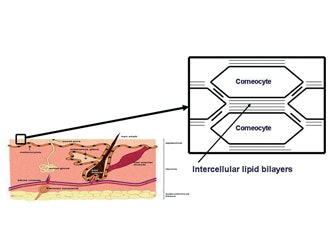
Caption: The Supported Location Where Lutein is Acting at Level of the Skin Lamellae.
Skin has extraordinary needs for antioxidants to cope with the oxidative stress constantly imposed by the environment and the aging process. Tocopherols and tocotrienols are the major radical scavenging antioxidants in cell membranes. Carotenoids protect cellular components from oxygen-mediated photo-oxidation by quenching singlet oxygen. Moreover, polyunsaturated fatty acids are important components of cell membranes for acquiring the proper membrane fluidity required for a wide range of biological activities in the cells.
In conclusion, carotenoids, tocopherols and bioactive lipids are essential components of a healthy diet for the skin. Tailor-made packages containing beneficial fatty acids, lipid soluble antioxidants (carotenoids) and vitamins, plant sterols and triterpenoids (tocotrienols) shall be included in the diet specifically designed for the internal care of the skin of different populations, according to the presentation by Barou Yang of the Dept of Biochemistry at the University of Turku.
Effective daily skin care products have to provide a primary and secondary shield to protect against immediate and long term effects of UV and blue light irradiation. In addition, advanced photoprotection needs the presence of antioxidant compounds to neutralize and deactivate photoproducts built under UV irradiation. A new technology for the molecular photostabilization of different chemical and natural compounds is provided by the innovative chemical bis-ethylhexyl hydroxydimethoxy benzy malonate for its cascading antioxidant efficacy. The activity of this new compound was presented by from Maria Cristina Pasi, PhD, the general manager of Merck Italia, who reported the around-the-clock activity of this ROS-quenching chemical.
The scientists working on the sidelines at the event were Professor Shengqing Ma, president of the congress; honorary president, Professor Hong-Duo Chen (Fig.11); Professor Xinghua Gao of the University of Shenyang; and Xinzhong Feng, secretary general of Shanghai University. Organizers of the event included Sukie Zhu, Qinglong Meng and Yuping Dai.
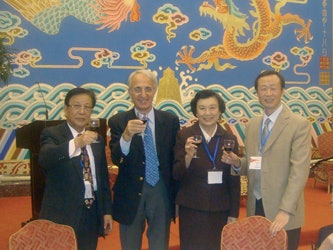
Caption: Professor Hong-duo Chen, Professor Pierfrancesco Morganti, Professor Shengqing Ma and Professor Wei Liu.
The Chinese hospitality has exceeded all the best expectations with the organization of the VIP dinner (Fig. 12), and the welcome banquet enriched with extraordinary meals and a wonderful spectacles (Fig.13). Through this meeting, China became a driving force in cosmetic dermatology. A successful international meeting depends on not only on the appropriate choice of the scientific papers, but also and sometimes in a decisive manner on the appropriate welcome organization.
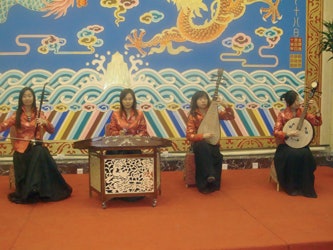
Caption: Performers at the VIP Dinner.
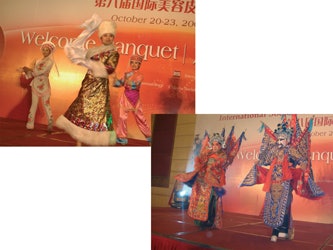
Caption: Dancing at the Welcome Banquet.
The 9th ISCD World Meeting will be held in Rome on October 22-24, 2009 on the subject, “Beauty Outside-in: East & West Working Together.” At this event, attendees will have the opportunity to create the base for a new well-being mix of the East and West ways of living. To learn more about the Rome event, e-mail: [email protected]. See you in Rome!
